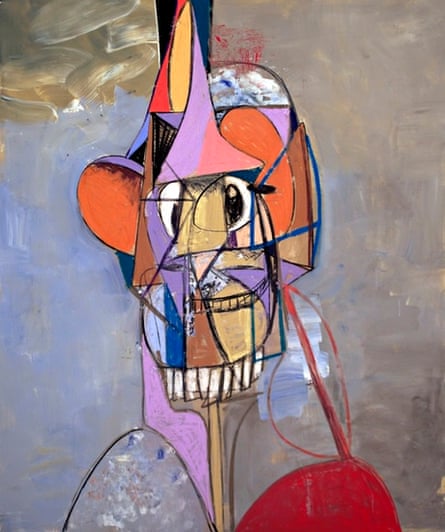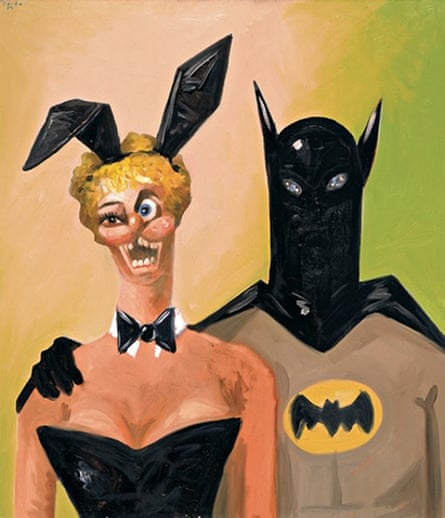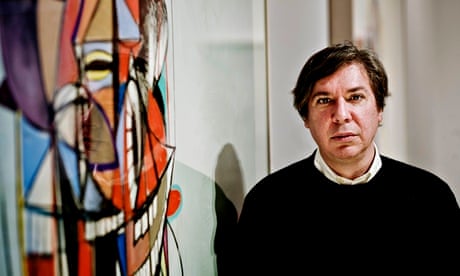Last May, George Condo had a near-death experience. The American artist was visiting Berlin after finishing a suite of ink drawings. "I guess my immune system was down and I was in a weird state of mind." "Weirder than usual?" I ask, as we look at those drawings at the Skarstedt Gallery, one of two London venues showing his work this month. "Much weirder," he says.
He points to the silhouette of a head dominating the foreground of a work called The Prisoner. Behind the silhouette are iron bars, and behind those is a prisoner facing us, whose head seems to have been flayed to reveal the throbbing orange cranium beneath. "That's where my mind was at." The ink drawings were to be the final portraits of a weird menagerie of archetypal figures – among them banker, butler, alcoholic, and an odd French guy called Jean Louis, who cropped up in various improbable guises including that of a French maid – that Condo had culled from his imagination and worked on for a quarter of a century.
"It's the last hurrah of the pods," he says. "I've done them in painting, drawings, sculpture. Ink seemed the fitting farewell, and I'm depicting them more extremely than ever before." When he calls these characters the pods, I can't help but think of the pods in The Invasion of the Body Snatchers, those alien duplicates bent on replacing humanity. At the Skarstedt, one of Condo's pods, naked apart from self-supporting stockings, stretches out on a Rothkoesque void of gesso pulling dismally at her hair. The title? The Discarded Human.
If Condo was in a weird way as he finished his ink drawings, things got worse in Berlin. "I got triple pneumonia after contracting legionnaires' disease." Isn't legionnaires' disease often "– fatal, yeah. My daughters had to take me in an ambulance to hospital when I became delirious." This is in Berlin? "Somehow I got home to New York, thank God. And then I collapsed. I was delirious in hospital. Lost 15 pounds. Nearly died."

The two London exhibitions display works that come shortly before and after that experience. The ink drawings are at the Skarstedt; at the nearby Simon Lee Gallery are a collection of works he made as he recovered. The latter are charged with Condo's hospitalised delirium. "I was hallucinating this guy when I was in hospital," says Condo. The guy he means is in the picture called The Wild Man of Borneo. "I didn't know who he was or where he came from. When I came out of hospital I started looking around for pictures of what I'd seen in my delirium, and I found it was the Wild Man of Borneo, a music hall act."
Condo has bumped off one set of imaginary creatures in one show, only to bring a new, even more delirious bunch to life for the other. These new pictures, he says, challenge the primacy of painting over drawing: most are in charcoal, with pastel and acrylic paint. Painting is usually conceived as fulfilment of drawing's promise, I suggest. "I want to reverse that," says Condo. "To stand up for drawing."
The Laughing Cavalier leers at us with protuberant teeth. "I love Frans Hals and this is me appropriating not just the subject but some of his painterly moves. But it all comes from me, ultimately. That's what I like to work from – my imagination." And what an imagination. As the New York Times put it in a headline: "A Mind Where Picasso Meets Looney Tunes".
This chimes with something his friend and one-time neighbour, the French psychoanalytical writer Félix Guattari, noticed when he visited Condo's studio when the artist was living in Paris in the 1990s. "Félix said I was the only portrait painter who ever painted entirely imaginary subjects. Picasso was always painting Dora Maar or whoever, Bacon's portraits could always be traced to some existing person. But not my portraits. They were all imaginary."
Guattari's observation was made before Condo started doing portraits of real-life people. It was made before Condo outraged the British nation (I'm kidding) with his 2006 portraits of our Queen as a long-necked, gerbil-cheeked, crown-wearing cabbage patch doll. It was also before he did the 2010 album cover for Kanye West in which the musician was painted naked and straddled by an armless, winged, naked female, possibly a phoenix – Condo's audacious stab at depicting the album's title, My Beautiful Dark Twisted Fantasy. It was the latter that caused a global run on parental advisory stickers, blue pencils and pixels.
Before those two affronts on public decency, Condo had fixated on imaginary characters whom he morphed, mangled, dismembered, disfigured and duffed up on canvases for many happy years. He might give any one of them three sets of teeth splayed hideously around the canvas, pairs of eyes that seemed to be not so much from different faces but different species. Hayward Gallery curator Ralph Rugoff, who put together Condo's 2011 retrospective, wrote that Condo's portraits amounted to an "anatomical orgy".
"I describe what I do as psychological cubism," says Condo. "Picasso painted a violin from four different perspectives at one moment. I do the same with psychological states. Four of them can occur simultaneously. Like glimpsing a bus with one passenger howling over a joke they're hearing down the phone, someone else asleep, someone else crying – I'll put them all in one face."
Condo laughs self-deprecatingly. He has a lovely New York baritone. But isn't he from New Hampshire? "I was, but there's no New Hampshire accent, so when I moved to New York in the late 70s I was open to its influence."

That openness to influence is even more characteristic of how he paints, riffing incessantly on the painters he loves – Rembrandt, Hals, Picasso, De Kooning, Rothko, Guston, Degas, whoever – in order to establish his own identity as an artist. "The only way for me to feel the difference between every other artist and me is to use every artist to become me." He points to a little patch of yellow pastel in the corner of a picture called The Laughing Clown. "That's me being fascinated with Degas's ballet dancers and wanting to work with his palette. It's like a cross between Hegel and Heidegger. The appearance of the painting suggests the being of the thing. And the simultaneous presence of various different psychological states adds up to what the object is." Righto, and Heidegger? "That's the idea of becoming. So you have this diversity of artistic influences in a picture and they're in a process of becoming – becoming the painting, something different and autonomous from the influences that go into it."
Excellent. I do hope that when Kanye West and Kim Kardashian visit Condo's Upper East Side studio, they chat about Hegel and Heidegger. It was Condo, incidentally, who painted Kanye's recent Christmas gift to Kim: a Hermès Birkin bag featuring three voluptuous nude women and an angry green monster. What Kim thought about the gift isn't yet known (though she carried it proudly before the paparazzi). But the Instagram community did not approve. "Holy shitballs, that is ugly," read one typical comment.
Unfair. Didn't they realise that Condo was alluding to classical depictions of the Judgment of Paris, with Kanye as green-faced Paris judging who was the most beautiful of the three goddesses, Hera, Athena or Aphrodite? Other Instagram users wondered if the value of the bag was diminished or enhanced by Condo using it as a canvas. Interesting question, particularly given that, while a Hermès Birkin bag can fetch up to $150,000, Condo doesn't exactly come cheap either. His 2004 painting The Last Days of Enron sold for $413,000.
"It's great to have Kanye West to collaborate with," says Condo. "He works off my paintings and my paintings work off his music. He does in music a lot of the stuff I do in painting – sampling, appropriating, presencing. He doesn't think of himself as a hip-hop artist but as an artist. Even his public persona is part of that art – it's another instrument he plays."
Condo could have been a musician, too. Born in 1957 in Concord, New Hampshire, he studied classical guitar, then switched to the lute. Is he still playing? "I play a little viola da gamba, but I gave up the lute after I asked Hopkinson Smith to help me tune it. He's a great lutenist, and when I played for him it sounded like someone putting a pickaxe through Michelangelo's David. Then I handed it to him and he played it beautifully. I guess the best that lute can get is that Hopkinson Smith played it – I should just leave it alone."
As a young art student in late-70s Boston, he joined a synth-based art-punk band called the Girls. When they played a gig in New York, he met fellow artist-musician Jean-Michel Basquiat. It led to a close friendship; Basquiat convinced him to move to New York. Once settled there, Condo managed to get an eight-month stint at Andy Warhol's Factory, during which time he met the great man only once. Years later, though, Warhol bought several paintings from one of Condo's first shows. Condo fitted into the art world easily, hanging with Basquiat, collaborating with William Burroughs, befriended by both Allen Ginsberg and Keith Haring.
But Condo only really established his artistic identity once he moved to Europe, first to Cologne, then Paris where he spent 10 years between 1985 and 1995. He lived on the Rue de Condé in the same building as Félix Guattari who became intrigued by the American's works whenever he visited the studio.
Like everybody else who's ever looked at Condo's paintings, Guattari noted that the American appropriated stuff from great painters and didn't deign to hide it. But Guattari noticed something more. "There is then a very specific 'Condo effect' which separates you from all the painters you seem to reinterpret," he wrote in a 1990 exhibition catalogue. "You sacrifice everything to this effect, particularly pictorial structure, which you systematically destroy, thus removing a protective guardrail, a frame of reference which might reassure the viewer, who is denied access to a stable set of meanings."
"I recognise that effect," says Condo when I put this to him. "It's what I call artificial realism. That's what I do. I try to depict a character's train of thoughts simultaneously – hysteria, joy, sadness, desperation. If you could see these things at once that would be like what I'm trying to make you see in my art." The resulting never less than clamorous oeuvre hasn't just proved marketable, but influenced other artists: Salman Rushdie wrote a chapter in his 2001 novel Fury about Condo's 1994 oil painting The Psychoanalytic Puppeteer Losing His Mind.
Today his works hang in the permanent collections of the Whitney and the Guggenheim, while their creator hangs not just with Kanye and Kim, but with Beyoncé and Jay Z, admiring their reportedly impressive collection of Basquiats and Ofilis.
As we reach one of his most impressive new paintings, In Darkness, which seems to echo Bacon's Study After Velázquez's Portrait of Pope Innocent X, I ask Condo for a frame of reference. "I guess it's a self-portrait," he says, then breaks into that baritone laugh again. "See the tortured artist?"

Comments (…)
Sign in or create your Guardian account to join the discussion